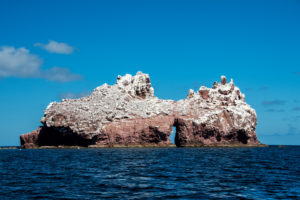Nestled between mainland Mexico and Baja California, the Sea of Cortez is home to a third of the planet’s marine mammals. This helps explain why Jacques Cousteau once referred to the region as the “aquarium of the world.” As the capital of southern Baja California, La Paz acts as a gateway to this incredibly biodiverse body of water. Common sights include orcas, blue whales, dolphins and immense shoals of leaping mobula rays. Although the Sea of Cortez is perhaps most famous for its cetaceans, visitors are often delighted to see California sea lions. These animals are both graceful and playful, and divers or snorkelers can meet them by the hundreds at the rocky outcrops of Los Islotes, a pair of islets about 45 minutes by boat from the city itself.
The sea lions of Los Islotes
Here, ochre rocks striped white with guano are home to melon-headed sea lion bulls who spend their days posturing and preening for the females. The bark of petulant males challenging another announces your arrival at the island long before you drop anchor. The lower sections of the islands are indiscernible beneath a carpet of sea lions basking in various states of repose, piled on top of one another with no apparent regard for personal space. The azure waters are alive with pups playing in the swell.
It is possible to interact with the Los Islotes sea lions either on scuba or snorkel. With depths of only 25 to 50 feet (8 to 15m), both methods offer a similar experience. Entering a body of water teeming with boisterous sea lions can be a little daunting, but once you take the plunge, you’ll find that the transformative silence of the underwater world turns the frenetic activity of sea lions into beauty rather than chaos. Instead of feeling intimidated, you’ll find yourself enchanted, as it becomes increasingly obvious that all the sea lion pups really want is for you to play with them. Their agility as they spin and dart around you will put even the fittest of human swimmers to shame.
Snorkeling with juveniles
The juvenile sea lions have definite personalities; some of them are shy, regarding you from a safe distance; the rest are irrepressibly naughty. The latter like to play chicken — swimming fast towards you, only veering away at the very last moment, blowing bubbles through their long whiskers as they circle around for the next high-speed fly-by. Their eyes are impossibly large in their puppy-like faces, and the bubbles catch in their fur like tiny droplets of liquid mercury. All around, dense shoals of silver sardines refract splinters of light as they split, divide and regroup around the darting forms of hunting sea lions. The water teems with life, and where diving is usually a spectator sport, the Lost Islotes sea lions give you the leading role in their playful circus.
 Other wildlife near Los Islotes
Other wildlife near Los Islotes
Although the sea lions are most certainly Los Islotes’ main attraction, the underwater landscape itself is also quite beautiful. One of the islets forms a natural arch, and those on scuba can explore its shadowed recesses, covered in stunning golden cup corals. Brightly colored king angelfish are common. Seahorses, vivid-scarlet Sally Lightfoot crabs and many other smaller species provide a worthwhile supporting act. Above the water, Los Islotes is a bird-watcher’s paradise. You may see pelicans, boobies and red-chested frigate birds.
The journey to and from the islets is an excellent opportunity to keep an eye out for other marine life, too. Often, super pods of bottlenose dolphin escort the tour boat on its way. And the misted column of a whale’s blow in the distance could mean anything from humpbacks to sperm whales. Anything is possible in the Sea of Cortez.
When to go
The best season for whales in the Sea of Cortez is from October and March, so this is a good time to plan your sea lion trip if you’d like the chance of incidental cetacean sightings. Sea lions are present at Los Islotes throughout the year. Different seasons offer the opportunity to see the colony at different points in their annual cycle. Summertime is pupping season on the islets. Early autumn is breeding season and the time of year when you must give obstreperous bulls the widest berth. Late autumn finds the adult sea lions building up their fat reserves for the winter ahead. Generally, only the juveniles take an interest in visiting snorkelers and scuba divers. For safety’s sake, don’t go too close to the rocks themselves. You don’t want to incur the wrath of the jealously territorial (and significantly more intimidating) bulls.
This is no hardship, however. At Los Islotes you needn’t approach the sea lion pups — their curiosity and playfulness will bring them to you. Some of the braver pups will even get a little too close. The mischievous among them will nibble on your fins if they feel they’re not getting quite enough attention. Swimming with them is nevertheless a safe and hugely enjoyable way to interact closely. The water at Los Islotes can be relatively cool, with average temperatures of around 68 F (20 C). Wear appropriate exposure protection to maximize your time in the water.


